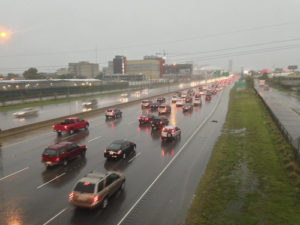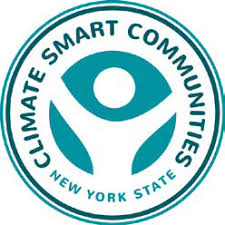Description
A significant portion of GHG emissions in Bethlehem, NY are due to commuting for work. (According to Bethlehem’s 2010 Greenhouse Gas Inventory, 48% of emissions are a result of transportation. According to the Bethlehem, NY 2021 community profile (completed as part of the comprehensive plan update process), “The majority of employed Bethlehem residents do not work within the town. Approximately, 14,722 residents commute each day outside of the Town while 9,043 non-Bethlehem residents come into the Town for work. Only 2,298 residents both live and work within the town.”) It is reasonable to assume that this is true for many other communities within the region.
In addition, more distant business travel results in significant emissions. Airlines account for 1.9% of global GHG emissions, and business travel accounts for 12% of that travel.
Actions that reduce daily commuting to work and travel to distant business meetings can reduce GHG emissions. Steps can include:
- Financial incentives for home offices.
- Outreach campaign to large city employers
- Encourage new coworking spaces in municipal/hamlet centers.
- Ensure broadband internet access throughout municipality.
- Allow a greater range of home-based businesses.
- Encourage reduced/consolidated work week.
- Encourage new telecommuting meeting centers to help people avoid business travel.

1
2
Implementation Phases
Encourage work from home to avoid local travel.
Encourage attending distant business meetings and conferences remotely.
Challenges
One challenge to this action is that it is dependent on the cooperation of employers.
Another difficulty is that in some cases, working from home can result in increased GHG emissions. When residents work from home, their house must remain fully heated in the winter and air conditioned in the summer. If workers traveled to an office instead, the thermostats of some of these homes could be set back during working hours. On a per-person basis, it is more efficient to condition one large building than it is to condition individual houses. Whether this loss of HVAC efficiency outweighs the gain of reduced vehicle miles depends on factors such as distance traveled, vehicle emissions (e.g. electric vs gasoline cars), and whether other people remain in the home during the day. One report says that it is more efficient to work from home if workers would otherwise travel more than 8 miles to their office. One way to mitigate this challenge is to encourage work at local coworking spaces rather than individual homes.
Example Municipalities
Several municipalities have already implemented this action…
- The city of San Antonio, Texas intends to reduce each persons VMT (Vehicular Miles Travelled) from an average of 24 miles per day to 19 miles per day by the year 2040
- The city of Minneapolis, Minnesota intends to reduce its VMT by 40% through the use of transit-oriented development, which includes new public transit and encouraging its residents to walk and cycle
- The city of Columbus, Ohio has installed six smart hubs to enable bike and car sharing to help those without vehicles in their daily life while also encouraging them to stay vehicle-free and environmentally sustainable
Greenhouse Gas (GHG) Reductions
Data
Two way miles travelled per car per day for work: 12.6 Miles [google maps]
Average working days in a year days: 261 [What Is the Average Number of Work Days Per Year Including Vacation Days?]
Assumption
Assuming vehicles drive from Bethlehem, NY to Albany, NY every working day, 6.3 miles each way.
Method
We calculated the:
- Distance travelled for work per car per year.
- Emissions per car per year traveling for work.
- Total CO2 emission by vehicle miles travelled per year for work.
Result
19560 metric tons of CO2e is reduced per year when the number of vehicles that travel outside Bethlehem, NY for work shift to in town jobs.
This results LARGE GHG emissions reductions.

Climate Smart Communities (CSC) & Clean Energy Communities (CEC) Link
This action is also related to several CSC and CEC actions for which you can get points toward certification…
CSC Actions:
CEC Actions:

Co-benefits
There are multiple co-benefits to completing this action, including:
- Economic savings from reduced miles traveled.
- Reduction in rush hour traffic and road rage.
- Reduction in accidents.
- Increased safety for pedestrians and bicyclists due to reduced vehicle traffic.
Resources
https://www.townofbethlehem.org/DocumentCenter/View/3045/Sustainable-Bethlehem-Program—Report?bidId=, page 72 Fig. 1.
https://ourworldindata.org/co2-emissions-from-aviation
https://www.investopedia.com/ask/answers/041315/how-much-revenue-airline-industry-comes-business-travelers-compared-leisure-travelers.asp
https://time.com/5948677/four-day-work-week-spain/
https://www.wsp.com/en-GB/insights/office-vs-home-working-how-we-can-save-our-carbon-footprint
https://www.aceee.org/files/pdf/white-paper/vehicle-miles-traveled-case-studies.pdf
https://www.cdc.gov/healthyplaces/transportation/vmt_strategy.htm
https://globalworkplaceanalytics.com/work-at-home-after-covid-19-our-forecast
https://www.onestl.org/toolkit/list/practice/reduce-vehicle-miles-traveled-vmts
https://www.weforum.org/agenda/2016/02/this-is-why-the-home-office-doesnt-work



